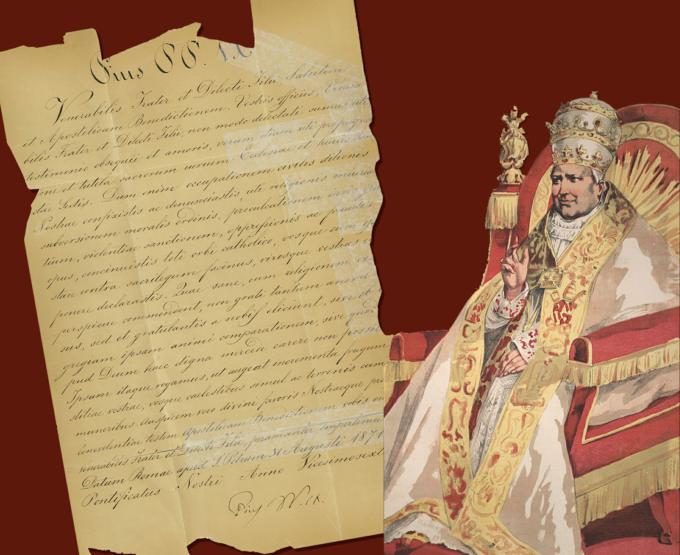
Culture
Because of these conflicting roles, he was viewed as a saint and martyr by some ... others viewed him as an autocrat who would not relent power over the Papal States.

Lester
Feb. 7 marks 140 years since the death of Pope Pius IX, whose tenure, upon further reading, proved incredibly tumultuous due to the political events taking shape in Italy during the 19th Century.
Pope Pius IX was born Giovanni Maria Mastai Ferretti on May 13, 1792, in Senigallia, Italy. At age 10, he entered a college in Volterra run by the Piarists, but withdrew in 1809 due to poor health. He would recover and resume studies in Rome, and was ordained a priest on April 10, 1819.
Over the next eight years he would serve at an orphanage, travel to Chile and Peru where he gained an interest in missionary work, and return to serve in a Roman hospice before being appointed Bishop of Spoleto in 1827, and then of Imola in 1832. During the latter, in 1840, he was elevated to cardinal, and on June 6, 1846, five days after the passing of Pope Gregory XVI, was elected his successor.
Since the early 19th century, the process of Italian unification had been underway, moving toward the eventual unification of all provinces into a single Kingdom of Italy in 1861. During this era, the pope was still the head of a temporal as well as a spiritual kingdom, with several provinces on the Italian peninsula comprising the States of the Church, or Papal States. With such an unstable political situation, electors saw Pius IX as a safe choice in that he was a native to these states, and therefore free of outside influence, and a moderate reformer who would appease both the liberal and conservative political elements.
His first years were met with great acclaim as he appointed more liberal reformers to key positions within his curia. He also improved relations with various nations, signing concordats with Russia (1847), Spain (1851) and Austria (1855), as well as reestablishing the Patriarchate of Jerusalem following discussions with the Ottoman Empire (1847).
Support soon waned, however, as pressure grew for the Papal States to join the unification movement. It is believed Pius IX favored Italian unification, seeing his primary role as spiritual leader of the world's Catholics as incompatible with his role as the leader of an Italian State, but at the same time was worried by perceived anti-clerical sentiments within the movement. The situation deteriorated as economic depression gripped the area, and in 1848 his prime minister was assassinated, causing him to flee Rome on Nov. 24, 1848.
A Roman republic was declared, but Pius IX returned to the city with the help of French soldiers on April 12, 1850, resuming his role as leader of the Papal States. Regardless, his was not a position of strength, and in 1860 much of the territory belonging to the Papal States joined the unification movement; the French troops once again the only thing preventing Rome from joining them. Finally, on Sept. 20, 1870, Rome was occupied and the temporal power of the pope effectively ceased.
Because of the complex events surrounding the rule of Pius IX, it would be unfair to offer judgement without a more in-depth study. As the leader of the Papal States he signed the aforementioned concordats with several European nations, but failed to stabilize the situation in his own provinces where the people were suffering, or adapt to changing political climate surrounding unification.
As a spiritual leader, he began revitalizing Catholicism in Germany, expanded the Church's missionary work, and established over 200 dioceses and missionary districts around the world. He also defined the Immaculate Conception in 1854 which caused an increase in Marian devotion; published the Syllabus of Errors which argued for the basic rights of the Church amongst a growing tendency toward reason, which had anti-religious undercurrents; and called for the First Vatican Council spanning 1869 to 1870. While he is acknowledged to have strengthened the Church within, with it came a centralization of power that would eventually be a source of concern and conflict with some Catholic nations.
Because of these conflicting roles, he was viewed as a saint and martyr by some, especially following the occupation of Rome. At the same time, others viewed him as an autocrat who would not relent power over the Papal States.
The archive holds several documents authored by Pius IX, including circular letters such as his explanation of the Immaculate Conception and Syllabus of Errors, as well as a few pieces of personal correspondence between himself with Bishop John B. Fitzpatrick and Bishop John J. Williams whose leadership of this diocese coincided with his papacy. It was Pius IX, in fact, who elevated Boston to an archdiocese in 1875.
- Thomas Lester is the archivist of the Archdiocese of Boston.
Recent articles in the Culture & Events section
-
What is truth?Michael Reardon
-
The 75th anniversary of St. Ignatius of Loyola Church, Chestnut HillThomas Lester
-
The most important prayer you already knowLaura Kelly Fanucci
-
Two years after DobbsRussell Shaw
-
Scripture Reflection for July 21, 2024, Sixteenth Sunday in Ordinary TimeDeacon Greg Kandra





